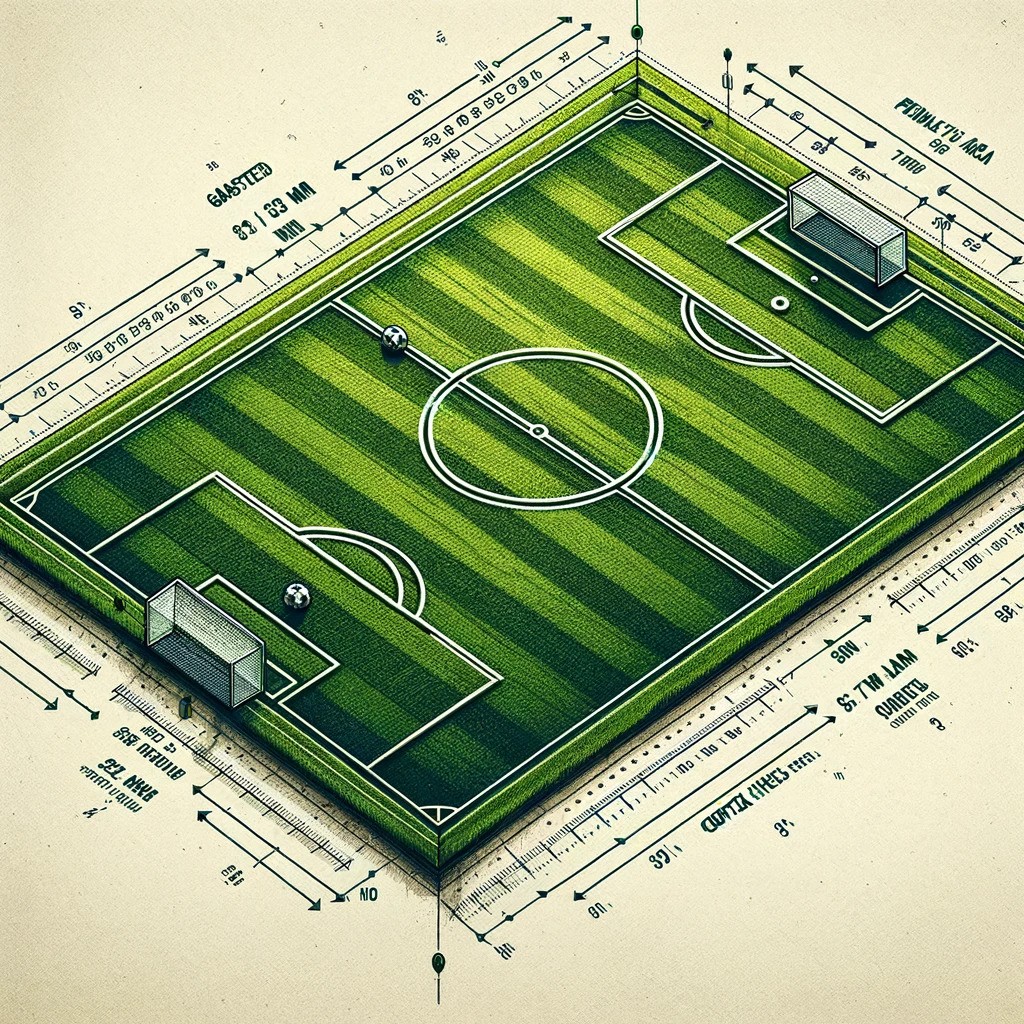As a lifelong soccer enthusiast, I’ve always been fascinated by the magnificent expanse of a FIFA soccer field. The freshly painted lines and glorious green grass immediately draw your eyes, transporting you to the heart of the game. You can picture the players strategizing over every inch of the field, their skills highlighted against the green backdrop. The field itself, a canvas of dreams and dramas, is not just a piece of grass but a symbol of global unity – a place where teams from around the World compete for the coveted Cup.
Delving into the specifics, many people, especially those watching from the comfort of their homes on TV, might not know exactly how large the field is. The dimensions of a standard FIFA soccer field are crucial not just for players but for fans to fully appreciate the game. The size of the pitch plays a significant role in the dynamics of the game. It’s something I’ve learned to pay close attention to, as it affects everything from the players’ stamina to the pace of the game.
Surprisingly, the net size also contributes to the game’s intensity. So, next time you’re covered in excitement watching a match, remember there’s more to the field than meets the eye. So, let’s now check out what exactly the size is of the FIFA soccer field.
How long is the soccer field in the World Cup?
In the world of sports, the dimensions of the playing area are vital, and this holds especially true for the World Cup pitch. To understand this, let’s compare: an American football field, including the end zones, spans 120 yards, which is the upper limit for a soccer field in the World Cup.
However, a World Cup field’s touch line—the long lines running from end to end—must be within 110 to 120 yards (or 330 to 360 feet), showcasing the substantial size of the pitch.
In contrast, an NBA basketball court is a mere 94 feet long, making it over three times smaller than the soccer field. This perspective highlights the vast expanse of the World Cup field, a scale that often depends on the exact stadium and field configurations.
H2: How wide is the soccer field in the World Cup?
In the grand spectacle of the World Cup, the width of the pitch holds as much significance as its length. The goal lines, those shorter lines stretching from corner flag to corner flag, must span between 70 and 80 yards (210 to 240 feet), a dimension that depends on the specific stadium.
By comparison, an American football field measures 53.33 yards wide (160 feet), while an NBA court stretches just 50 feet across, making it over four times smaller than a World Cup soccer field.
This comparisons starkly highlight the expansive nature of the soccer field, showcasing how it dwarfs other professional sports fields in sheer size and scale.
What is the official size of the FIFA soccer field?

According to FIFA, the field of play must adhere to specific dimensions: it is required to be 105 metres in length and 68 metres in width. This area, bounded by goal lines and touchlines, forms the stage where global soccer dramas unfold. The rectangular shape of the field is marked with continuous lines that define its boundaries, ensuring clarity and fairness in the game.
These lines not only demarcate the areas of play, but they also extend beyond to encompass additional areas. This includes the grassed area, which is crucial for player warm-up areas and assistant referee positions. FIFA’s guidelines ensure that this area is sufficient to facilitate player safety, providing enough space in front of advertising boards to minimize the risk of collision and any abrupt change in surface near the touchline or goal line, which could adversely affect a player’s footing.
Furthermore, the design of the stands, the position of advertising boards, and sightlines are all taken into account when determining the dimensions of the grassed area. FIFA recommends a benchmark: a level surface, ideally the same surface type as the field of play, extending at least two metres beyond each touchline and goal line.
For larger stadiums, a total distance of five metres beyond each goal line and four metres beyond each touchline is advised before the placement of perimeter advertising boards. Conversely, in smaller stadiums, these distances are slightly reduced to four metres behind each goal line and three metres beyond each touchline.
The incline of the surface beyond these two metres is another critical aspect, with FIFA stipulating that any incline should not exceed 5°, maintaining a level playing field in the most literal sense. This attention to detail in the dimensions and orientation of the field, in conjunction with the stadium’s design, plays a pivotal role in ensuring the game’s integrity and the players’ safety.
Pitch surrounding area
The pitch area of a FIFA soccer field is a meticulously planned space that includes not only the field of play but also the extended grassed area. This area extends to the very boundary of the spectator viewing areas, marking a clear demarcation between the game and the audience. In a well-designed stadium, this boundary is more than just a separation; it encompasses a further area beyond the grassed area and advertising boards.
This additional space is vital for the positioning of security staff and photographers, ensuring that all operational aspects of the game are smoothly integrated without intruding into the action on the field.
In ensuring a comprehensive and safe environment, the pitch area is deliberately kept unobstructed. There are no permanent installations, walkways, staircases, or emergency exits from the stands that impede free movement around the field of play. This design philosophy not only enhances the viewing experience but also prioritizes safety and efficiency.
Furthermore, all surfaces within this area, including those surrounding the pitch, are made of non-slip material, reflecting FIFA’s commitment to player safety and maintaining a high standard for the playing environment.
How big is a soccer net in the World Cup?
In the high-stakes games of the World Cup, every detail counts, including the specifications of the regulation net. These nets are 24 feet wide and eight feet tall, a size that’s carefully measured to ensure uniformity across all matches. The width is gauged from the inner edges of the vertical posts, while the height is determined from the ground to the bottom edge of the crossbar.
It’s crucial that the posts and crossbar are of the same width and depth, which cannot be larger than five inches. This standardization is essential not just for fair play but also for maintaining the global prestige of the tournament.
How big is the penalty area in the World Cup?
The penalty area in a World Cup soccer field, often the scene of high drama and crucial plays, is a larger, rectangular box surrounding the net. It measures 44 yards wide and 18 yards long, a sizeable space where the unique role of the goalkeeper comes into play. Once the goalkeeper leaves this area, they no longer have the privilege to use their hands and must conform to the rules of the players on the field.
For this reason, you’ll rarely see goalkeepers venturing out of this pivotal zone, as it is both their stronghold and operational base during the game.
How big is the goalie box in the World Cup?
Within the dynamic world of World Cup soccer, the goalie box plays a critical role. Nestled inside the larger penalty area, this smaller, rectangular box is a crucial zone for goalkeepers. Measuring 12 yards wide and six yards long, it’s a relatively compact area where goalkeepers can use their hands and make game-changing saves.
The dimensions of the goalie box are meticulously defined to balance the game, providing goalkeepers with enough room to operate, yet not so expansive as to give them an undue advantage.
Conclusion
The dimensions of a FIFA soccer field, from the expansive field of play to the strategically sized goalie box, are designed with precision, balancing fair play and excitement in the world’s most beloved sport. These measurements, encompassing the penalty area, goal lines, and pitch surroundings, are not just figures on paper but represent the global standard of soccer, ensuring consistency and fairness across international pitches.
Whether it’s the 105 by 68 meters of the field, the 44 by 18 yards of the penalty area, or the 12 by 6 yards of the goalie box, each element plays a vital role in crafting the thrilling experience of World Cup soccer, highlighting the intricate blend of strategy, skill, and spatial awareness that defines this beautiful game.
Frequently Asked Questions
What are the official dimensions of a FIFA soccer field? The official dimensions of a FIFA-regulated soccer field, also known as a football pitch, are between 100-110 meters in length and 64-75 meters in width. These standards are set by the International Football Association Board (IFAB) as per the Laws of the Game.
How many acres are in a soccer field?
A typical professional soccer field, following FIFA regulations, covers an area between 1.59 and 1.99 acres. For instance, a field measuring 115 yards in length and 75 yards in width equates to approximately 1.78 acres.
How big is a World Cup soccer field?
A World Cup soccer field must conform to FIFA’s guidelines, requiring a length of 110-120 yards (100-110 meters) and a width of 70-80 yards (64-73.2 meters). These dimensions ensure global standardization for World Cup matches.
How big is a soccer field in feet?
International soccer fields vary in size but must measure between 330-360 feet in length and 210-240 feet in width. The total surface area of these fields ranges from 69,300 to 86,400 square feet.

